RESEARCH ARTICLE
Social Exclusion and High-Speed Railways: Evidence from China
Labib Azzouz1, *, Anson Jack2
Article Information
Identifiers and Pagination:
Year: 2021Volume: 15
First Page: 133
Last Page: 146
Publisher ID: TOTJ-15-133
DOI: 10.2174/1874447802115010133
Article History:
Received Date: 17/11/2020Revision Received Date: 18/1/2021
Acceptance Date: 5/2/2021
Electronic publication date: 07/07/2021
Collection year: 2021

open-access license: This is an open access article distributed under the terms of the Creative Commons Attribution 4.0 International Public License (CC-BY 4.0), a copy of which is available at: https://creativecommons.org/licenses/by/4.0/legalcode. This license permits unrestricted use, distribution, and reproduction in any medium, provided the original author and source are credited.
Abstract
Background:
Despite their economic, social, and environmental advantages, HSRs are associated with some negative social impacts and controversy about their equitability.
Gap:
Very few studies have explored the relationship between HSR and social exclusion.
Aims:
This paper examines the relationship between HSR and social exclusion, and it focuses on China as a case study.
Objectives:
The objectives of the study are as follows; to identify the most important and favourable factors for choosing HSR from passengers' perspective; to reveal issues and reasons that inhibit passengers from using HSR and limit their accessibility to the service, and to propose some solutions and interventions.
Methods:
The study utilizes an online survey comprising a set of stated preference and revealed preference questions. A total of 3655 responses were collected, of which 3353 responses were complete and useful.
Results:
A key finding is that comfort is proven to be the most favourable factor for using HSR, followed by travel time and reliability. Another finding is that the economic exclusion followed by the geographical exclusion is prevailing across different age and monthly income groups of non-HSR users. Those who have the lowest income and the elderly experience the strongest levels of economic exclusion. Moreover, physical, time-based, and fear-based exclusions are also notable.
Conclusion:
To create a modal shift from other modes to HSR and allow more groups to access the service, HSR should be competitive in terms of affordability and accessibility. Possible solutions and policy interventions that may help to tackle categories of social exclusion in China are presented.
1. INTRODUCTION
High-speed railways (HSRs) constitute a distinct feature of our modern societies, as a transportation mode that shrinks spaces and shapes places [1]. Featuring safety, speed, capacity, and sustainability, HSRs are proven to be flexible systems that can be designed and built to suit different contexts and cultures [2]. If appropriately designed and implemented, HSR can meet the mobility needs of individuals and societies, boosting the economic development of some regions and increasing accessibility and connectivity. In a safe and reliable manner, HSR, when compared with flights and cars, minimize negative impacts on the environment, featuring a competitive transportation mode for medium- to long-distance trips [3-5].
Despite their economic, social, and environmental advantages, HSRs might be associated with some negative social impacts and controversy about their equitability. These impacts often spark several discussions and studies on topics of social exclusion, social segregation, affordability, accessibility distribution, land acquisition, and other topics that might hinder the social sustainability of HSR. For instance, Chen and Wei [6] linked the development of HSR to the segregation of social classes. De Rus and Nombela [7] debated the social profitability of HSR. Monzón, Ortega [8] addressed the spatial equity impacts of HSR in Spain. Qiu and He [9] looked at factors that influence Chinese passengers’ choice when they consider travelling by HSR. Briginshaw [10], Delaplace and Dobruszkes [11], and Chiambaretto and Fernandez [12] discussed the introduction of the OUIGO in France, an affordable HSR service that offers tickets at low prices. Shaw, Fang [13] and Yang, Guo [14]explored how the development of HSR in China has greatly increased overall levels of accessibility throughout different regions and provinces of the country. Martínez, Tordesillas [15] examined the mobility and territorial impacts of HSR in Puertollano and Ciudad Real in Spain. Finally, Yang, Ma [16] examined whether the development of HSR improves the equalisation of medical and health services in China.
Most of the previous studies focus on one or two specific exclusion types, such as economic exclusion or geographical exclusion, while much fewer studies have linked HSR to all types of social exclusion. Of these, few studies [17-19] also looked at HSR and social exclusion in European countries. Particularly, rare contributions are presented that tack HSR and social exclusion in the Chinese case, and most of these have focused on economic exclusion without necessarily considering all exclusion categories. To fill this research gap, this paper aims to examine the relationship between HSR and the seven forms of social exclusion, namely: physical exclusion, economic exclusion, geographic exclusion, time-based exclusion, fear-based exclusion, space-management exclusion, and exclusion from facilities. The paper will focus on China as a case study. Selecting China serves many purposes. First, it will allow for the comparison between previous findings of the European countries and new findings of the Chinese case. Second, it will provide insights into a country in which the HSR experience is relatively new, especially when compared with other countries. Third, it could reveal some findings that might be necessary to influence policies and decisions to accompany the development of the expanding HSR network in China.
The objectives of this study are as follows; to identify the most important and favourable factors for choosing HSR from passengers perspective; to reveal issues and reasons that inhibit passengers from using HSR and limit their accessibility to the service; and to propose some solutions and interventions for alleviating forms of the social exclusion.
2. THE DEVELOPMENT OF THE CHINESE HSR
By the end of 2017, the Chinese HSR network reached a length of more than 25,000 route-km and constituted by far the world’s longest HSR network, followed by Spain and Japan with networks of 3100 route-km and 3041 route-km respectively. In 2018, the length of the network, as in Fig. (1), reached around 29,000 km accounting for more than two-thirds of the global HSR network for commercial services [20-23]. By the end of 2019, there was more than 35,000 km of HSRs in service in China [24]. The logic behind the development of the Chines HSR system has changed in parallel with the continuous growth of the network. Initially, the objective was to introduce an efficient rail system with improved services and to increase the capacity of the overloaded network. Most recently, the focus is on boosting economic development and urbanization by enhancing the connectivity of regions and provinces [21].
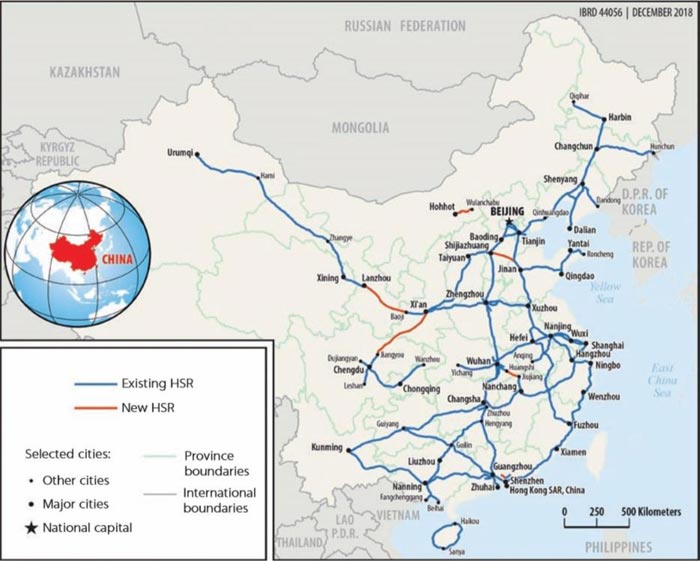 |
Fig. (1). The Chinese HSR network in 2018. Source [21]: |
When compared with conventional railways, HSRs are generally operated at higher speeds and frequencies [25]. However, HSR tickets are significantly more expensive. For example, a trip from Shanghai to Hangzhou takes one hour and costs around CNY 50-80, compared to 2-3 hours and almost CNY 27 with conventional railways [26]. HSR stations are often located outside city centres in suburbs and rural areas, while conventional railway stations mostly exist in city centres [6]. This indicates that access/egress costs to reach and/or leave HSR stations may be higher than those of conventional railways.
3. LITERATURE REVIEW
Social exclusion as a theoretical concept has been widely discussed by scholars and researchers. Levitas, Pantazis [27] define social exclusion as the lack or denial of resources, goods, and services, and the inability to engage in activities and actions that are enjoyed by most people in the society, whether in economic, cultural, or political dimensions. Applying the idea of social exclusion to transportation disadvantage has several benefits and great potential. It assists policymakers and planners in understanding that: (1) the problem has multi-dimensions as it can exist both in affected individuals’ circumstances and conditions and in institutions and structures of the wider society; (2) it is dynamic, as it can change positively or negatively over time and space; and (3) it is relational, as it can be obvious by comparison to normal activities enjoyed by the rest of the population [28].
Factors that may prevent socially excluded people from using transportation services could be classified into seven major categories as the following [29]:
- Geographical exclusion; in which individuals are not able to access transportation services due to living or working in remote locations, islands, peripheral zones, and rural areas from which it is hard to reach transportation links [30].
- Physical exclusion; where physical barriers prevent certain groups from accessing transportation services. These barriers are related to the poor design and inappropriate ergonomics of transportation facilities and the built environment. Excluded groups include those with special physical and psychological needs such as children, elderlies, visually impaired people, and those who cannot speak the local languages [31].
- Economic exclusion; represent by high monetary costs associated with traveling and using specific transport services. These could limit unemployed people from accessing the job market and accessing suitable vacancies [32].
- Time-based exclusion; due to lack of free time for travelling for specific classes in the society such as carers and mothers of young children. Time poverty affects both genders from different age and income groups, leaving them with very tight schedules [33].
- Fear-based exclusion; where individuals fear for their personal safety in public and private spaces. These spaces include waiting halls in stations, congested queues near ticket machines, and congested trains. Personal attitudes of individuals range from concern, awareness through fear, and worry to terror. These feelings remarkably vary between genders.
- Space exclusion; which refers to the security and the management of public spaces that could prevent people from using these spaces. For instance, space exclusion could be related to the lack of VIP and first-class waiting halls in stations [34].
- Exclusion from facilities; where time, income, and other constraints prevent people from accessing shopping centres, leisure establishments, and educational and healthcare facilities [35].
Pagliara, Pompeis [19] explored the relationship between HSR and social exclusion in England. The study used a revealed preference survey and investigated passengers’ perceptions of social exclusion categories. The findings of the study revealed a link between social exclusion and HSR, showing that the most relevant and prominent forms of social exclusions were economic and geographical exclusions. Moreover, HSR users stated their preference to use the service mainly because of reductions in travel time.
Another study by Pagliara, Biggiero [17] focused on the HSR and social exclusion across three European countries, namely, Spain, Italy, and the UK. The study used a revealed preference survey via online platforms, asking participants about factors that inhibit them from using the HSR service. The study found that economic exclusion followed by geographical exclusion was the most significant among other social exclusion categories in all countries, especially among those with low income. Moreover, Italy faced the strongest level of geographical exclusion while Spain and the UK mostly perceived economic exclusion.
Qiu and He [9] looked at factors that influence Chinese passengers’ choice when they consider travelling by HSR. The study obtained data from the Nanguang HSR passenger travel survey and linked the socioeconomic attributes of travellers with factors of travel time, travel cost, and travel distance. The findings of the study show that monthly income, travel time, and the source of travel expenses have a great impact on the probability of selecting HSR. In other words, Chinese travellers are mainly concerned about time and money.
Shaw, Fang [13] and Yang, Guo [14] found that the development of HSR in China has greatly increased overall levels of accessibility throughout different regions and provinces of the country, besides boosting the regional socio-economic exchange. Moreover, HSR has reformed accessibility’s spatial patterns, creating zones and corridors of high-reliability levels, mainly concentrated in cities near or around HSR stations [13, 14]. However, introducing HSR has widened the gap in the spatial distribution of accessibility values, and the most significant changes in these values are witnessed in cities that are directly connected to the HSR network. In contrast, cities that are not directly connected to the network were less advantaged since changes in their accessibility values are lower [14].
Martínez, Tordesillas [15] examined mobility and territorial impacts of the AVE – the HSR service of Spain – in Puertollano and Ciudad Real. The study used a survey and gathered 4245 responses from AVE passengers. The survey examined the mobility habits of passengers and their transportation preferences before and after the introduction of AVE. The study detected some forms of social inequalities, mainly due to the location of HSR stations in both cities. In Ciudad Real, the HSR station is located in the periphery of the city, with good coordination and integration with other transport modes. In contrast, the station of Puertollano is located in the city centre, with poor coordination with other modes besides the non-existence of city buses in the vicinity of the station. As a result, the station of Ciudad Real was found to be more accessible than Puertollano station. The number of passengers who were able to reach Ciudad Real station by cars and buses was significantly higher than the number of those who accessed Puertollano station using the same modes [15].
Liu and Kesteloot [36] explored the impact of the Wuhan-Guangzhou HSR line on migrant workers of the Qiya village in China. The study looked at HSR as a tool for delivering access to new economic opportunities in the job market of big urban centres. Findings revealed that HSR failed to ease workers’ migration process because while HSR offered a time-efficient mode, migrant workers – considering their low income – preferred cost-efficient travel. In other words, HSR was not affordable for the migrant workers' group. Moreover, the arrival of HSR was accompanied by reductions in passenger traffic on conventional lines in favour of freight. This decreased the number of rail seats that suit cost-sensitive migrant workers. Liu and Kesteloot [36] concluded that HSR generates social differentiation within rural towns, separating more than before workers who are cost-sensitive from those who are time-sensitive.
Finally, Chen and Wei [6] discussed that the development of HSR in China is associated with serious social effects, including social segregation between society’s classes, rapid expropriation, and land acquisition issues. The study discussed that migrant workers usually gather in conventional railway stations, which are regarded as a symbol of chaos. In contrast, the minority who can afford expensive HSR fares gather in HSR stations which feature the modern face of China and technological advances. Moreover, the study stated that HSR is not affordable for most of the Chinese population.
4. METHODOLOGY
Understanding passengers’ preferences and perceptions about HSR through travel surveys have several benefits. First, it helps authorities and policymakers to better understand travel demands while notifying them to take into consideration appropriate social inclusion policies and solutions [37]. Also, it assists HSR operators in improving the quality of their services both in trains and stations, aiding the application of the appropriate pricing optimization to attract more passengers while keeping current users [38, 39].
This study is based on gathering information about factors that prevent passengers from using HSR in China. For this purpose, an online survey has been prepared, comprising a set of stated preference and revealed preference questions. The online survey was developed and launched on the WJX.CN platform using the Star Survey tool. The platform is well-known in China and is used by different institutions from the academic, financial, industrial, and technological sectors. These include the universities of Fudan, Peking, Shanghai Jiao Tong, and Tsinghua. The platform allows researchers to reach respondents from different age groups, occupations, income, and education levels.
Questions of the survey were written in Mandarin, the official language in China. Before its official launch, the survey was tested with 17 native Mandarin speakers. These volunteers comprise friends of the author, their family members and colleagues, from different age groups and occupations. All volunteers stated that they comprehended all questions easily without confusion, confirming the clarity of the survey.
The online survey was officially launched in Summer 2019 over a period of around 65 days. A total of 3655 responses were collected. To ensure the robustness of collected data, all responses were carefully reviewed, and a total of 302 suspicious responses were set aside due to containing misleading or inconsistent information. For instance, some respondents stated that they live in provinces that do not match the IP address of devices from which they responded to the survey. As a result, the final number of full, valid, and useful responses was 3353. Moreover, some features provided by the online platform have been activated to prevent respondents from submitting more than one response. This allowed the avoidance of repetition and duplication. The survey featured a wide geographical coverage and responses from participants of different provinces and cities. Responses came from Beijing, Shanghai, Hubei, Hunan, and almost all other Chinese provinces. The numbers of responses of some provinces were higher than those of others.
The first part of the survey collected data related to the socioeconomic background of participants, including their age, nationality, gender, education, monthly income, and occupation. In the second part, participants were asked about; their favourite transportation mode for a long-distance trip -150km or more- travelling from and to different locations in China by coach, normal train, HSR, car, and plane; whether they have ever used HSR; and, the most favourable factor for choosing it. Then travelers were asked about the transport mode they chose in their last trip -150km or more- and the purpose of that trip.
After that, participants were asked to select the strongest barrier that prevents them from using HSR. These barriers were categorized into seven categories, in accordance with the previously presented seven types of social exclusion, as discussed by [29]. Participants could select only one category, and all categories were explained by simplified examples to help participants comprehend options and to assist the selection process. The following list shows how some options were presented in the survey:
- Geographical barrier. For example, it is hard to reach the train station; the nearest HSR station is very far away.
- Economic Barrier. For example, HSR ticket is expensive, and I cannot afford it.
- Space-management exclusion. For example, HSR stations lack necessary shops, amenities, waiting halls, or seating areas.
- Physical barriers. For example, HSR stations and/or trains lack the necessary facilities for the elderly and disabled users.
- Fear-based barrier. For example, I have fears for my personal safety when using trains; I have fears of being in an HSR station as it is very crowded.
- Time-based barrier. For example, I am very busy; I do not have enough time to travel.
- Exclusion from facilities. For example, I do not have access to hospitals, shopping, education, or other facilities in the destination city.
Then, across-analysis is provided to understand the relationship between exclusion categories and socioeconomic characteristics of non-HSR users. A benchmarking exercise is offered to compare the findings of the study with results of similar studies of [17, 19] in Spain, Italy, and the UK. Finally, a hypothetical scenario was prepared, presenting three HSR travelling options, which feature a trade-off between travel time and travel cost, from which participants were asked to choose one. Table 1 presents the socioeconomic characteristics of both the whole sample and non-HSR users.
5. RESULTS AND ANALYSIS
Fig. (2) illustrates that around 70 per cent of the sample has previous experience with HSR, compared to almost 30 per cent of those who have never used the system before. Noticeably, the number of male users is relatively higher than the number of female users. This might be related to the variation in social responsibilities and positions held by women compared to men, leaving females with less time and money to travel.
| Characteristics | Levels |
All users (n=3353) % |
Non-HSR users (n= 1060) % |
|---|---|---|---|
| Age | 18-21 | 10.53 | 11.49 |
| 22-30 | 29.35 | 29.62 | |
| 31-40 | 32.39 | 30.95 | |
| 41-50 | 20.49 | 20.53 | |
| 51-65 | 6.29 | 6.52 | |
| 66 or above | 0.95 | 0.89 | |
| Gender | Male | 48.88 | 48.2 |
| Female | 51.12 | 51.8 | |
| Nationality | Chinese | 94.51 | 94.5 |
| Other | 5.49 | 5.5 | |
| Education | High school or bellow | 25.95 | 29.5 |
| College | 38.26 | 40.25 | |
| Bachelor | 29.67 | 24.73 | |
| master's degree | 4.68 | 4.29 | |
| Ph.D. and above | 1.43 | 1.23 | |
| Occupation | Full-time/ part-time job | 32.57 | 32.7 |
| Student | 16.31 | 16.85 | |
| Freelancer | 35.61 | 33.52 | |
| Unemployed | 6.89 | 7.24 | |
| Retired | 4.32 | 4.59 | |
| Other | 4.29 | 5.1 | |
| Monthly income | ¥2500 or bellow | 30.96 | 36.22 |
| ¥2500 - ¥5000 | 45.21 | 43.72 | |
| ¥5000 - ¥10000 | 19.98 | 16.72 | |
| ¥10000 and above | 3.85 | 3.34 | |
| Travel type | Alone | 23.71 | 27.69 |
| With a partner | 32.36 | 30.35 | |
| With a friend | 26.57 | 23.7 | |
| With colleagues | 5.07 | 4.89 | |
| With family | 12.29 | 13.37 | |
| Trip purpose | Work | 19.03 | 19.97 |
| Study | 22.46 | 22.24 | |
| Holiday | 33.16 | 31.16 | |
| Personal activities | 25.35 | 26.63 |
 |
Fig. (2). The experience of using HSRs by gender. |
The study asked participants to state their preference regarding favourite transportation mode for a journey of 150 km or more and also the actual mode they chose -revealed preference- in their last trip of the same length. Fig. (3) shows that the results of stated and revealed preferences are close to each other, indicating that the normal train is the most favourable mode, followed by HSR and cars. Coaches and planes are much less popular when compared to other modes. Also, more than half of those who did not use HSR on their last trip have used the normal train. The popularity of the normal train over HSR could be related to several reasons. Normal trains are more frequent and typically offer cheaper tickets and more options in terms of departure and arrival time. Moreover, those who are not very concerned about travel time can travel by normal trains at night considering the availability of sleeper options. Furthermore, it is easier to reach normal train stations, which are usually located in the city centre while HSR stations -in most cases- are in peripheral zones in urban suburbs, making it harder to reach them due to longer access/egress times [6, 40, 41].
Also, participants were asked to refer to the most important factor they think is favourable and encouraging for using HSRs. Considering the whole sample, Fig. (4) shows that comfort ranks first, with around 28.5 percent of the sample selecting comfort as the most favourable factor. Moreover, travel time, reliability, and cost are also notable factors with percentages of 18.9 per cent, 18.1 per cent, and 16.5 per cent, respectively. Seat availability, environmental impact, and safety are selected as favourable factors by less than 10 per cent of the sample, while station facilities and management are barely selected as favorable factors.
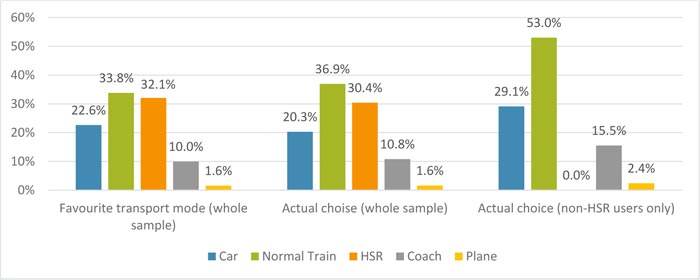 |
Fig. (3). Stated favourite transport mode for a 150km trip vs. actual choice of non-HSR users. |
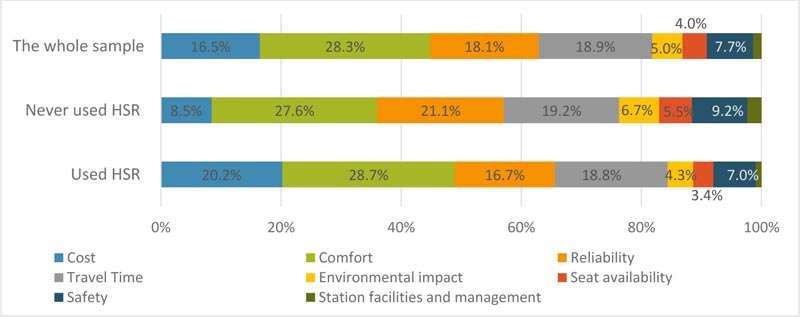 |
Fig. (4). Favourable factors of using HSRs. |
Fig. (4) distinguishes between those who have and who have never used HSR before. A clear distinction exists between these two groups in terms of selecting the cost as a favourable factor; around 20 per cent of those who have used HSR selected cost as a favourable factor, compared to 10 per cent of those who never used HSR before. This implies that HSR users are relatively more satisfied with costs associated with traveling by HSR, while those who have never tried the service might be holding the perception that HSRis an expensive service, hypothetically preferring it for factors of comfort, reliability, and travel time.
Table 2 presents social exclusion categories among HSR and non-HSR users. Economic and geographical exclusions constitute the top two categories for both types of users. However, a clear distinction is present between them; the geographical exclusion seems to be most relevant for HSR users, while the economic exclusion is dominant in the case of non-HSR users. Also, the exclusion values of HSR users are relatively closer to each other, compared to non-HSR users’ values, where gaps between categories are more significant. Physical exclusion ranks the third for both users, while other categories of time-based and fear-based exclusions are also notable for both HSR and non-HSR users. There are no significant differences between the perceptions of males and females since their percentages are relatively similar.
A cross-analysis has been provided to explore the relationship between social exclusion categories and socioeconomic attributes of non-HSR users reflecting on their age, monthly income, education level, occupation, besides other mobility-related choices such as the purpose of the trip and mode choice.
Fig. (5) illustrates the relationship between social exclusion categories and the monthly income of non-HSR users. The economic exclusion is dominant across the sample, with around 38 per cent of respondents are seeing themselves excluded from using HSR for economic reasons. The values of the economic exclusion noticeably decrease with higher incomes, to be replaced by geographical and physical exclusions, which are values that grow steadily. Low and low-medium income groups face the highest levels of economic exclusion, with around 47 per cent and 37 per cent of travelers being economically excluded, respectively. In contrast, different forms of exclusions are dominant in other income groups; geographical exclusion is prevailing in the medium-high income group. The highest-income group experience the strongest levels of physical and fear-based exclusions. Su, Luan [37] found that Chinese business and high-income travellers are very concerned about their safety and convenience in stations.
| Exclusion type | Males n=1639 |
Females n=1714 |
Total n= 3353 |
|||
|---|---|---|---|---|---|---|
| HSR users n=1219 |
Non-HSR users n=420 |
HSR users n=1074 |
Non-HSR users n=640 |
HSR users n= 2293 |
Non-HSR users n= 1060 |
|
| Economic Exclusion | 10.6% | 20% | 9.8% | 17.6% | 20.4% | 37.6% |
| Geographical Exclusion | 15.2% | 13.8% | 13.6% | 13.6% | 28.8% | 27.4% |
| Physical exclusion | 8.1% | 6% | 7.6% | 6.9% | 15.7% | 12.8% |
| Fear-based exclusion | 6.8% | 3.3% | 6% | 3.9% | 12.6% | 7.2% |
| Time-based exclusion | 7.2% | 3% | 8.3% | 5.7% | 15.5% | 8.8% |
| Space exclusion | 1.6% | 1.2% | 2.5% | 2.5% | 4.2% | 3.6% |
| Exclusion from facilities | 1% | 0.9% | 1.7% | 1.6% | 2.8% | 2.6% |
| Total | 50.49% | 48.2% | 49.5% | 51.8% | 100% | 100% |
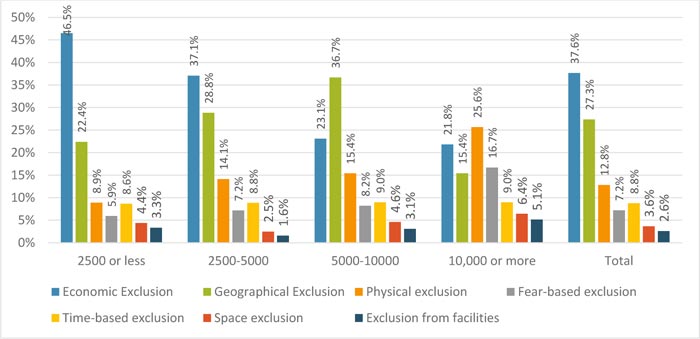 |
Fig. (5). Social exclusion types vs. monthly income for non-HSR users. |
The relationship between social exclusion categories and the age of non-HSR users is presented in Fig. (6). Except for the middle-aged group, economic exclusion prevails in all other groups, followed by geographical and physical exclusions, respectively . Noticeably, the 51-65 age group suffers the strongest economic exclusion compared to other groups.
Significantly, the eldest group perceives the highest level of physical exclusion, and almost a quarter of people aged 66 or above are seeing themselves as physically excluded. This is specifically important since it might refer to two facts: (1) the lack of disabled and accessibility facilities -both in HSRs’ trains and stations- that suit the special needs of elderly people; (2) the lack of disabled and elderly facilities in metro stations and other transportation modes which hinder accessing HSR stations.
The eldest age group perceives the strongest level of fear-based exclusion, with around 15 per cent of people in this group see themselves as excluded due to fears for their personal safety. This could be related to the fact that the elderlies are less familiar with modern technologies and relatively less accustomed to the modern HSR system in China, especially considering its high speeds when compared to other modes with which the elderly are more familiar with. Fear-based exclusion could also be linked to the spread of negative news. For instance, the HSR accident in Wenzhou in 2011, which killed 40 passengers, resulted in a drop in ridership [42].
Fig. (7) shows social exclusion categories based on the trip purpose. Economic exclusion dominates other exclusion categories for people who travel for work, holiday, and personal purposes. Respondents who travel for work commitments face the strongest level of economic exclusion. For those who travel for study purposes, the geographical exclusion is the highest category. Students enjoy discounts on their HSR tickets [43], and hence they are less excluded for economic reasons. However, students might be living in rural and peripheral urban areas where HSR stations are relatively far and harder to reach.
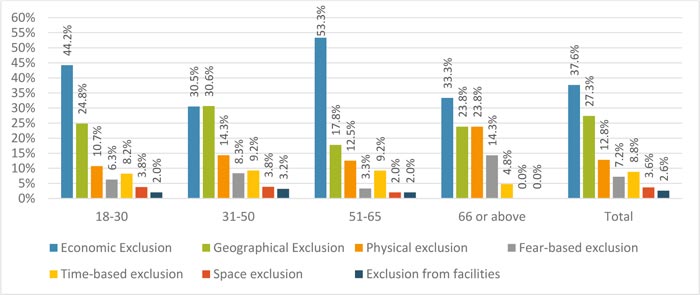 |
Fig. (6). Social exclusion types vs. age for non-HSR users. |
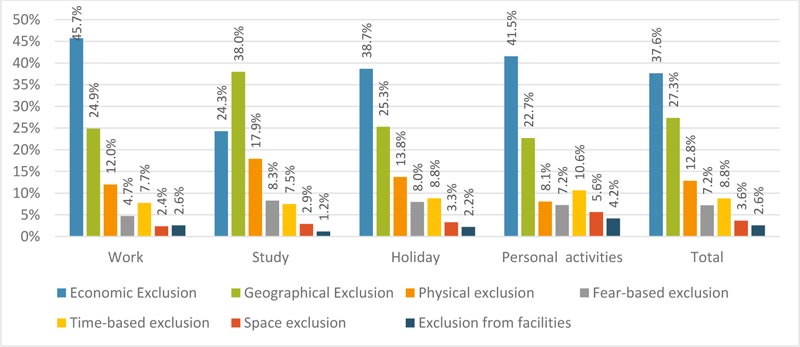 |
Fig. (7). Social exclusion types vs. trip purpose of non-HSR users. |
Finally, the relationship between social exclusion categories and chosen transportation mode is summarized in Fig. (8). The highest level of exclusions received by car, regular train, and coach users are economic exclusion followed by geographical exclusion. Only in the case of plane users the geographical exclusion dominates other exclusion categories. This is understandable since travelling by HSRs in China is relatively more expensive than travelling by car, normal trains, and coaches. In contrast, travelling by plane could be much more expensive than travelling by HSRs, and since air users are less concerned with monetary costs, they are concerned with geographical and time-based exclusion. This might be explained by the fact that plane users in China find it easier and more convenient to reach an airport than to reach an HSR station. Another possibility is that airports provide special facilities such as VIP and business lounges, which might not exist in stations.
Pagliara, Biggiero [17] explored the relationship between HSR and social exclusion categories in three European countries, namely; Italy, Spain, and the UK. Fig. (9) summarizes the findings of one of the studies [17] together with the results achieved by authors in the Chinese case. The economic exclusion in all countries -except Italy- is dominant, followed by geographical exclusion. Also, travellers in the UK and Italy suffer the strongest levels of economic and geographical exclusions, respectively. The values of economic and geographical exclusions in China and Spain are somewhat close to each other.
However, the comparison indicates that the Chinese study found the highest level of physical exclusion, with around 13 per cent of travelers perceiving themselves to be physically excluded compared to 10 per cent, 5.6 per cent, and 10 per cent in the UK, Italy, and Spain, respectively. This indicates that the expectations of passengers and possibly those with special needs and accessibility difficulties are not properly met and catered for. Also, in China, the research found the highest level of fear-based exclusion, with around 7 per cent of travellers perceiving fear-based obstacles, while figures of this category are close to zero in other countries.
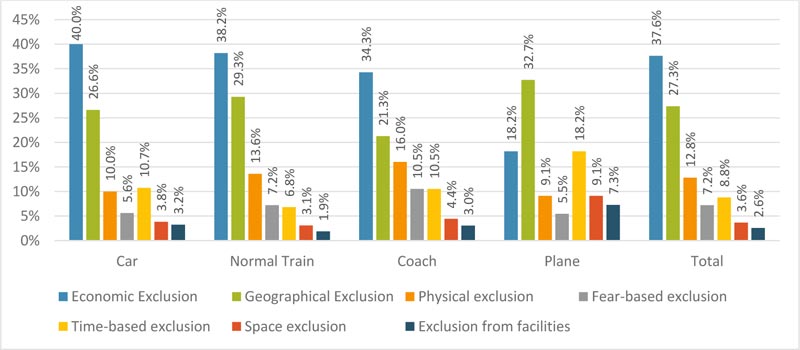 |
Fig. (8). Social exclusion types vs. transport mode for non-HSR users. |
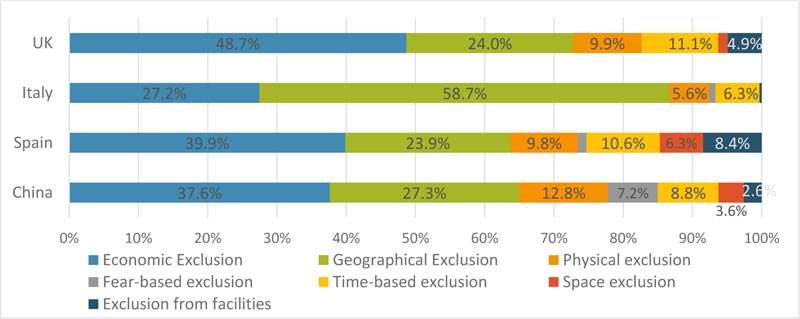 |
Fig. (9).
Social exclusion types’ comparison for non-HSR users in four countries. Source: Author’s findings, with findings of Spain, Italy, and the UK retrieved from a study [17]. |
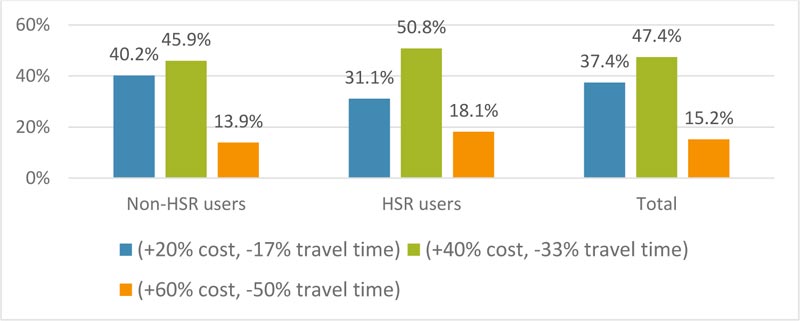 |
Fig. (10). Hypothetical scenario: trading off between time and money. |
Fig. (10) illustrates a hypothetical scenario that aims to understand both HSR and non-HSR users’ trade-off between time and money. In this scenario, travelers were given three alternate options of travelling by HSR for a 600 km trip that typically took 120 minutes and cost ¥200. Each option facilitates a further 17 per cent reduction in travel time accompanied by a 20 per cent increase in travel cost. Fig. (10) shows that both HSR and non-HSR users preferred the second option, followed by the first option, with around half the travelers choosing an option that grants them medium travel time and cost, and almost 37 percent selected the cheapest option. Only 15 per cent picked the fastest option. These suggest that in China, sensitivity to travel cost is higher than to travel time. Zhao, Zhao [44] discuss that in the Chinese case, travelers find higher speed less important than departure and arrival times. Another finding is that HSR users are more concerned about the time and less sensitive towards the cost when compared with non-HSR users, affirming the higher levels of economic exclusion faced by non-HSR users, which was revealed by Table 2 earlier in this study.
6. BROADER DISCUSSION
6.1. Potential Reasons Behind Findings
The issue of social equity is barely developed. Despite boosting the overall accessibility levels across different regions, the development of HSR in China – as in many countries around the world – has raised a wide range of spatial equity concerns and polarisation issues. In this study, selecting comfort as the most favourable factor for using HSR in China is relatively surprising, especially when other similar studies found that travel time dominates other factors. For instance, Pagliara, Pompeis [19] surveyed passengers in the UK and found that travel time is selected by more than half the sample as the most favourable factor for using HSRs. Also, Leboeuf [2] conducted a travel survey in countries of Spain, France, and the UK and found that travel time and travel cost are the strongest parameters that drive mode choice. Findings from the Chinese case suggest that comfort can join travel time and travel costs as the most favourable factors for using HSRs. Choosing comfort could be explained by the fact that passengers in China are relatively satisfied and happy about their overall HSR experience and the convenience and comfort they get while in trains and stations. Chen and Wei [6] discuss that HSR stations demonstrate Chinese modernization and technological advances featuring cleanliness, futuristic architecture, massive waiting halls, clean toilets, and other facilities. Other forms of comfort are provided in HSR trains, such as comfortable seats, plenty of leg rooms, air-conditioning, and on-board food and drink services [45]. In contrast, traditional rail stations are considered a symbol of chaos where workers from rural areas gather in busy spaces that are less clean and tidy [6].
It is debatable that geographical exclusion is only related to the location of the station. While most Chinese HSR stations are located in peripheral zones and suburban areas [6], HSR stations in many European countries such as Spain, France, and Germany are located in city centres [2]. Still, according to the benchmarking exercise, the geographical exclusion is present and significant in both China and Europe. Another factor that can reinforce geographical exclusion is inadequate and inefficient integration and coordination between different transport modes [46]. HSR stations connect with other parts in cities through connecting modes that comprise public transportation and private mobility. The poor connectivity to the station through these modes could increase the number of people who are geographically excluded [15].
Perceiving fear-based exclusion in China might be related to the high levels of crowding in stations, where passengers fear for their personal safety and belongings. Major HSR stations such as Beijing South Station and Shanghai Hongqiao Station handle a massive crowd of up to 4.82 million passengers during the Spring Festival only [46, 47]. Another reason is that the HSR experience in China is relatively new, especially when compared with Japan and many European countries that had their HSR systems at earlier stages. The first HSR service in China was available to the public in 2008 [21], and some Chinese travellers might not yet be fully accustomed to the HSR system. There is a need to address key safety and security issues during such events to reduce fears and to enhance the safety perception of both HSR and non-HSR users. Other studies have found similar results; for example, Hickman, Chen [48] surveyed passengers exploring their expectations and experience of facilities in three main HSR interchanges in China. The study found that specific parts of these hubs are subject to severe congestion and long queuing, which hinder the safety, feeling of security, and the personal space of passengers. Moreover, the special needs of people with disabilities are not seen as being properly catered for.
6.2. Potential Solutions and Interventions
Different solutions and interventions can tackle different forms of social exclusion. HSR operators could consider the provision of door-to-door (DTD) mobility solutions to reduce geographical exclusion. Regular coaches and minibusses that operate between HSR stations, peripheral zones, and remote areas could increase access to HSR stations. Modal coordination is required for providing a seamless and hassle-free journey, and communication technologies, integrated ticketing, and mobile apps play an essential role in this regard [2].
In the Spring Festival, a massive number of people use the HSR service in China. Migrant workers and those who originate from rural and remote areas might not be very familiar with the technology and mobile ticketing, and hence they might prefer to line up in queues to purchase their tickets [49]. To ease the ticket purchase process and reduce the number of people in queues, a group ticket could be introduced, where a ‘candidate’ can buy one ticket for a group of friends or colleagues. Less queuing means fewer congestions, and fewer travellers will be concerned about their personal safety.
Physical exclusion could be alleviated by providing appropriate accessibility facilities and adequate ergonomics design, which should be available during the whole journey in stations, trains, and connecting modes. Maximum utilization of communication technologies such as mobile phones and E-watches could ease access to timetable information and travel updates. Moreover, in Japan, JR East employs information robots to assist passengers with physical disabilities and those who are not fully accustomed to the rail system [50]. Other solutions include using elevators and ramps to remove uneven ground and installing guiding blocks to assist impaired passengers [51]. Also, DTD solutions could facilitate obstacle- and hassle-free journeys for the elderly and disabled people.
The economic exclusion could be mitigated by offering discounted tickets to the elderly, retired people, and other groups who perceive high levels of economic exclusion. Since offering discounted tickets might decrease the overall revenues, governmental subsidies could be offered to cover the loss in the short term. However, in the long-term, HSR operators in China should be able to secure a sustainable source of income by engaging in other transport and non-transport activities both locally and internationally. These include the management of real estate, tourism and entertainment activities, and financial services. SNCF and the Central Japan Railway Company diversify their businesses and engage in a wide range of mobility and non-mobility activities to generate additional income [52].
Finally, the provision of specific in-stations facilities such as VIP waiting halls and high-quality lounges is necessary for meeting the needs of business travellers and those with higher incomes, and hence reducing space management and fear-based exclusions. HSR stations should offer some services that are available at airports to attract air transport passengers.
6.3. Limitations and their Implications on Findings
In this study, participants could tick only one option when selecting the strongest factor that prevents them from using HSR. However, it is worth mentioning the relevance of interdependencies between multiple criteria when conducting travel surveys. Travel decisions are usually not based on a single criterion, and travellers take into consideration a combination of factors before selecting or rejecting a transport mode [53, 54]. In other words, participants who perceived a strong level of economic exclusion might also be subject to geographical, physical, and other types of exclusion. Similarly, those who favoured HSR because of the comfort the system offer might also favour it for other reasons such as savings in travel time and reliability. This study revealed that around 37 per cent of non-HSR users perceive economic exclusion as the strongest barrier that prevents them from using HSR. However, the actual number of participants who suffer from economic obstacles might be much higher, and the same judgment applies to all other exclusion categories. To conclude, the results of this study reveal a minimum value for each type of exclusion, and the actual values might be much higher. Another limitation is that using an online survey excluded those who do not have access to mobile devices/ laptops/ stable internet connection and/or are not familiar with using technologies.
In terms of validity, the study used a survey that is thoroughly researched, influenced by, and based on existing knowledge. A similar survey has been used and verified by other studies such as [17-19]. Also, the results of the survey were compared through benchmarking exercise with authenticated results of other studies in different countries. Benchmarking results against findings of similar studies in other countries confirmed the dominance of economic exclusion followed by geographical exclusion. The similarity of findings enhances the validity of the results of this study [55]. Still, statistical validation of the sample size and results would enhance the findings of the paper. Without such validation, results and findings are limited to the sample of 3353 respondents and cannot be generalised to the Chinese population.
CONCLUSION
This study looked at the relationship between HSR and social exclusion categories and focused on China as a case study. One interesting aspect of this paper is that while many previous pieces of research in the field have focused on HSR users, this paper considered both HSR and non-HSR users. Also, previous researchers analysed the negative impacts that accompany the arrival of HSR on social equity and sustainability. This paper was devoted to exploring users’ perceptions and thoughts about obstacles that prevent them from using HSR. In their papers, scholars focused on one or two exclusion categories, such as economic and geographical exclusion, while this paper looked at the seven types of exclusions as identified by [29]. Finally, the subjective nature of the survey used in this study was useful to cultivate an authentic dialogue that succeeded – to an acceptable level – in generating reliable and valid results.
In many European countries, travel time is the most favourable factor for using HSR [2]. However, the case study showed that in China, comfort is regarded as the most favourable factor, followed by travel time and reliability. The experience of HSR is relatively new in China, especially when compared with other European countries. In China, HSRs are perceived as a new, comfortable, and clean transport mode, featuring comfortable seats, plenty of leg rooms, air-conditioning, and on-board food, drinks, and other services that are not available in other modes [45].
This study sought to explore the perceptions, thoughts, and ideas of people about HSR, including those who never used the system before. This is very important because identifying reasons for which non-HSR users might choose the system could be utilized in the future to attract them to use it. In other words, to potentially create a mode shift from other modes to HSR.
The economic exclusion followed by the geographical exclusion were dominant across different age, and monthly income groups of non-HSR users. This means non-HSR users are mainly excluded due to expensive tickets or low accessibility to departure/arrival stations, especially those who live in rural and peripheral zones. Those who have the lowest income retired people and the elderly perceived the strongest levels of economic exclusion. Also, those who travel for study purposes perceived the highest level of geographical exclusion. Physical, time-based, and fear-based exclusions were also notable in the Chinese case since they were perceived by many respondents that cannot be underestimated. In specific, the elderly perceived the strongest levels of physical exclusion, possibly due to the lack of facilities that address their mobility needs in trains, stations, and during their journey from and to the station.
Responses to the hypothetical scenario showed that passengers were more concerned about travel cost than travel time. However, this trend changes with higher incomes and people with the highest income prefer the fastest travel option. China was similar to Spain, Italy, and the UK with regards to the fact that the economic and geographical exclusions are the strongest among other categories of exclusion. However, respondents in China perceived the highest levels of physical and fear-based exclusions when compared with other countries.
To create a modal shift from other modes to HSR and allow more groups to access the service, HSR should also be competitive in terms of affordability and accessibility. Potential inclusion solutions and interventions could be explored by HSR operators and decision-makers to tackle the forms of social exclusion identified in China, and these should target different groups. For alleviating the economic exclusion, integrated and discounted tickets could be provided to more users such as the elderly. Cheaper HSR services similar to the OUIGO service in France could be introduced. Door-to-door services and adequate coordination between HSR and other modes are necessary to reduce both geographical and physical exclusions. DTD luggage service could ease the travel of students and migrant workers. Appropriate ergonomics design and the implementation of accessibility facilities that meet the needs of the elderly and disabled people could help to cut physical exclusion. For instance, assistive glasses can help visually impaired passengers. Mobile ticketing can reduce the number of people in queues, decrease crowds, and make the flow of passengers more efficient. Fewer congestions in stations and fewer crowds can reduce the fears of some travellers. Group tickets can be introduced to help migrant workers and others who are not very familiar with technologies. Finally, VIP and business waiting halls could reduce fear-based exclusion.
Future research could focus on each of the presented social exclusion categories. For instance, the fear-based exclusion could be deeply examined across genders and age groups, while other studies could explore physical exclusion. Similar future research could ask participants to specify the location in which they live and its accessibility to HSR stations. Also, it could ask about the origin and the destination of their last trip as this will help to understand the mode choice.
CONSENT FOR PUBLICATION
Not applicable.
AVAILABILITY OF DATA AND MATERIALS
The authors confirm that the data supporting the findings of this study are available within the article.
FUNDING
The project is funded by the University of Birmingham’s Postgraduate Research Scholarship (2016-2020), the Council for At-Risk Academics’ Grant (2016-2019), the Council for At-Risk Academics’ Postdoctoral Grant (2020-2021).
CONFLICT OF INTERESTS
The authors declare no conflict of interest, financial or otherwise.
ACKNOWLEDGEMENTS
The assistance of professor Tim Schwanen of the Transport Studies Unit at Oxford University and the constructive comments of two reviewers on earlier versions of the manuscript are gratefully acknowledged.








